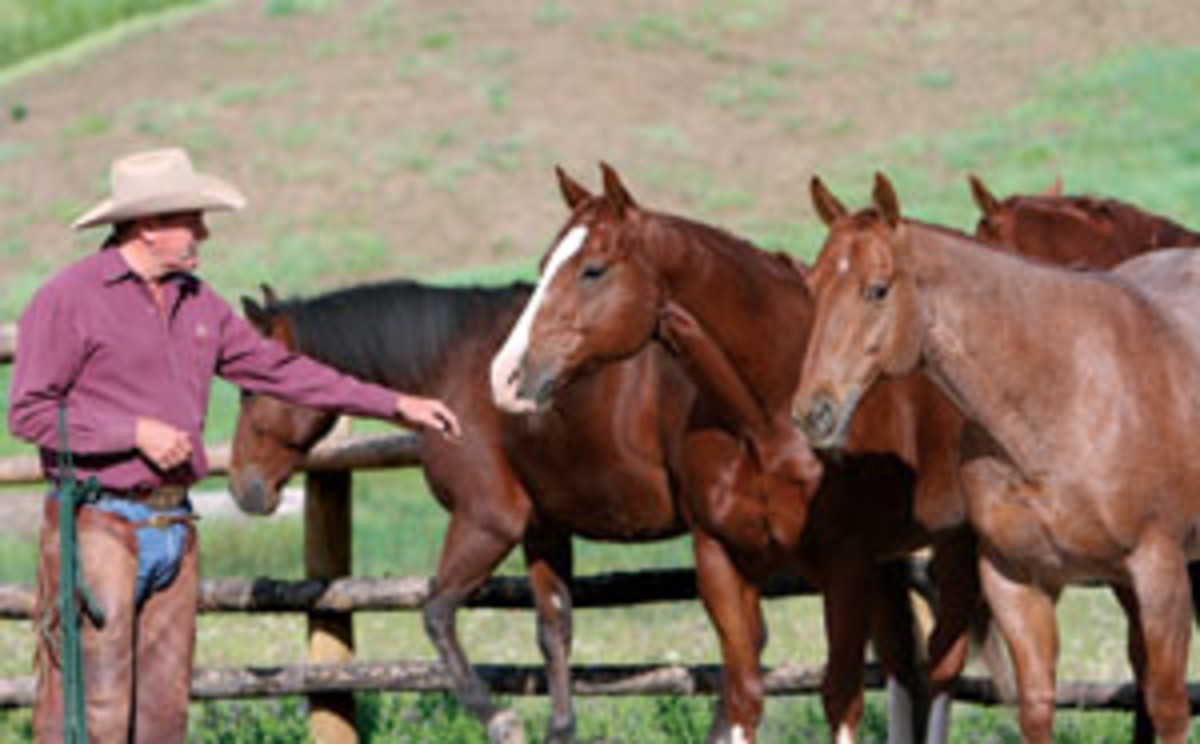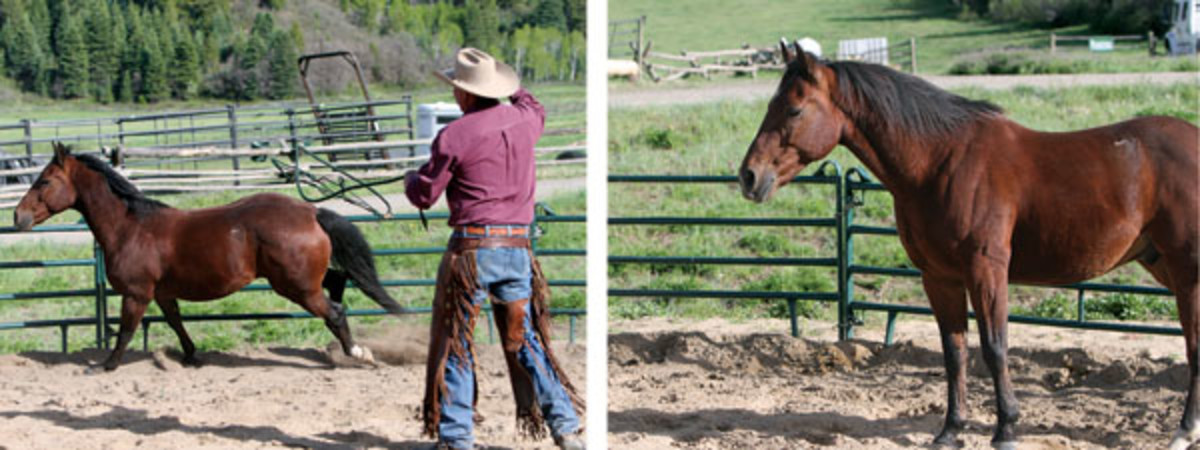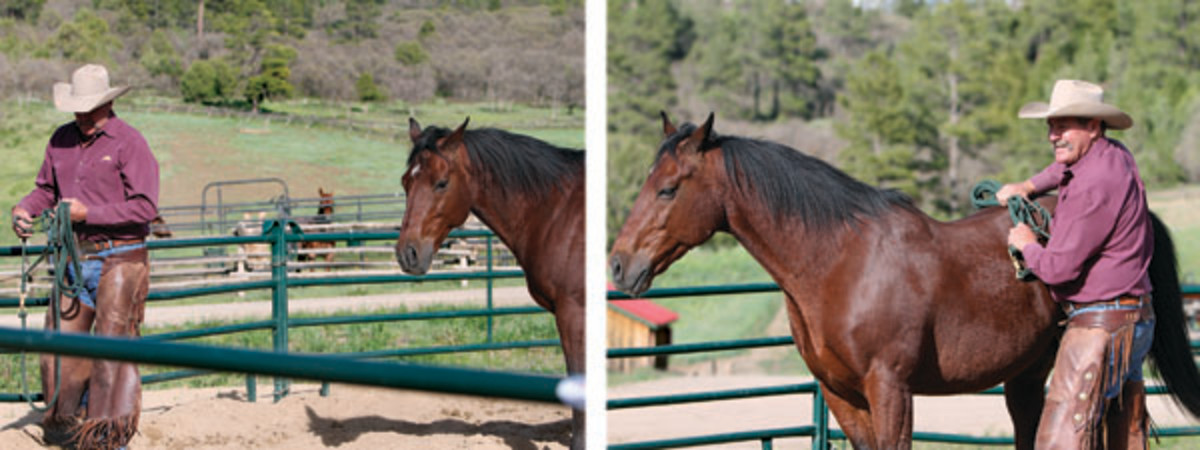Q I board my 14-year-old Half-Arab gelding in a pasture setting with six other boarded horses. Catching him in the pasture has proven to be quite the difficult task. Can you help me understand how this hard-to-catch behavior develops and how to change it?

Jim Lock, Tennessee
A In the wild (and in their DNA), horses, as prey animals, are designed to be hard to catch. It’s their most important instinct because it ensures their survival.
[READ MORE WITH PARELLI: Rein Positions]
While that might be true for horses, it can be really frustrating for us. It can make our interactions with our horses hurried, anxious, and not very enjoyable, which defeats the entire purpose of having horses in the first place. And these emotions scare the heck out of our horses! To change this, we first have to understand where horses are coming from. Then we need to know how to change this. Innately, horses are afraid of us (predators). When we change our behavior, they’ll change theirs.
Why a Horse Doesn’t Want to Be Caught
Aside from that innate instinct, there are usually two other reasons a horse becomes hard to catch.
The first is that many horses today get started under saddle before they’re truly tamed. That is, you might be able to ride the horse, but there’s no trust. You’re both probably on the defensive. The easiest stage to begin the taming process is when the foal is first born, using foal imprint training. You establish your presence as a member of the herd from the start, which overrides the horse’s instinct to see you as a predator. You can do this later in life, but it’s a lot more difficult and time-consuming.
The second reason a horse might be hard to catch is that people are direct-line thinkers, which means our plan is to go out; catch the horse; bring him in for riding, shoeing, deworming, etc.; and then turn him back out. The horse catches on to this. He realizes that the only time you go catch him is when you’re going to do something to him. He associates your catching him with things he doesn’t like.
Use Routine to Your Advantage

We’re teaching our horses all the time, good things or bad things, consciously or not. Horses are easily programmed, and we can use this to our advantage. Rather than only going out to catch your horse to do something to him, take time to catch him to do something for him, such as give him a good scratching, do some soothing grooming, offer a little extra grain, give him a fresh drink, or offer him something else he enjoys. Don’t be so direct-line. See it from the horse’s point of view, and this will change the game. Your horse will look forward to you turning up.
If catching your horse is difficult, read the following steps to help change that, and then keep in mind the routine tips I’ve mentioned. Keep seeing things from your horse’s point of view.
Go for the Easy Catch
You mentioned that your horse lives in a pasture situation, which is fairly common for horse owners. Begin the catching process by calling all the horses in from the pasture to a smaller corral. Use the same call every time—a whistle, or another sound, to call them in—and then offer a little extra grain or scratching once they’re all in the corral. Establish a feeling of, “Woohoo! The people are here!” when you call.
Once you have all the horses gathered in the corral, resist the temptation to go get the horse you want. Instead, catch the first one that comes to you. There’s bound to be one horse that wants to be caught; whether or not it’s your horse doesn’t matter. If you catch the easiest one, others are sure to follow. If you send the easiest catch away, you’re sure to just churn up the entire group, leading to all of them running around the corral. (“Catch” can also mean you rub and scratch the first ones that come to you until finally yours is next in line.)
Continue catching one horse at a time, and if others are with you, include them in the process. This teamwork between you and your barnmates will build camaraderie, and those who arrive after the catching session will be happy to have their horse ready in the barn. (And they’ll likely return the favor the next time they’re first to the stable.)
Train Your Horse to Catch You

If your horse still proves to be one of the harder ones to halter in the big group catch, work on this drill in the round pen.
Without a halter on your horse, send him around the round pen at a good pace. You can encourage his forward motion in different ways: with a training stick, by twirling a lead rope behind him, or by tossing the rope halter and lead (but not a halter with metal buckles that could bruise him) behind him to encourage forward movement around the pen.
As the horse runs around, his adrenaline will go down and he’ll start to look for an answer. You’ll notice his ear turn toward you; he’ll start to slow down and then want to stop and look at you. Allow him to halt and face you by softening your body language. If he doesn’t, then send him around the pen a few more times. If he does, invite him to walk toward you by backing up several steps to help him feel safe to approach. While he approaches, carefully coil the halter and lead.
When he gets to you, approach him quietly. Make coming to you a pleasant experience by rubbing all over his body with the rope halter and lead. Use it as a massager to make your horse feel good when he’s with you. Then put the halter on your horse and go about your business of grooming, riding, or whatever you had planned.
Go through this routine every time you catch your horse, and it should involve less and less loping around the round pen and quicker catching. It’ll eventually result in your horse being the one that’s easiest to catch when you bring the herd into the corral from the pasture.
Pat Parelli and his wife, Linda, are the founders of Parelli Natural Horsemanship and present major seminars and demos around the world. Learn more about their philosophy and check their schedule of presentations at parelli.com.






